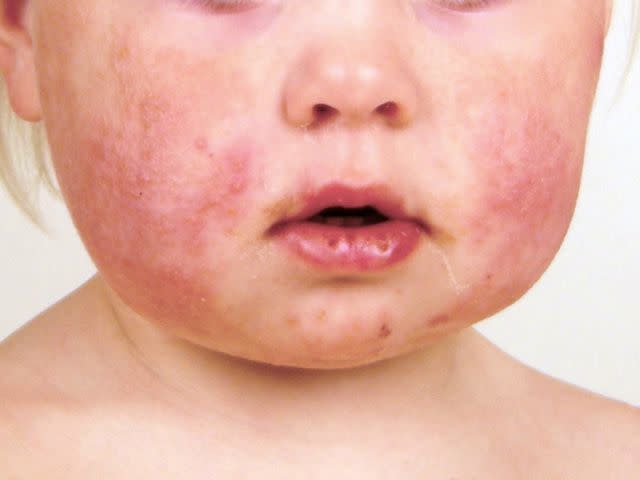Gianotti-Crosti Syndrome: A Common Childhood Rash
Medically reviewed by Jonathan B. Jassey, DO
Gianotti-Crosti syndrome, also known as papular acrodermatitis of childhood, is a skin rash that typically affects infants and young children. In addition to a rash on the arms, legs, buttocks, and face, Gianotti-Crosti syndrome may cause flu-like symptoms and a general feeling of malaise.
Gianotti-Crosti syndrome is usually caused by a delayed reaction to a viral infection, such as Epstein-Barr virus (EBV, or mononucleosis), cytomegalovirus (CMV), or hepatitis B (HBV).
This article covers everything readers need to know about the condition.
What Causes Gianotti-Crosti Syndrome?
Gianotti-Crosti syndrome is caused by a delayed overreaction of the immune system to a viral illness. The symptoms typically appear while a child is recovering from a viral infection. Some live virus vaccines, such as the poliovirus and live influenza (flu) vaccines, may also trigger Gianotti-Crosti syndrome in children up to the age of 12.
Viruses that can lead to Gianotti-Crosti syndrome include:
EBV
Hepatitis A, B, or C (most often B)
CMV (a genus of viruses causing diseases such as chickenpox, herpes simplex, and mononucleosis)
Coxsackieviruses

Reproduced with permission from © DermNet dermnetnz.org 2023
What Are the Symptoms of Gianotti-Crosti Syndrome?
The symptoms of Gianotti-Crosti syndrome are more likely to appear in the spring and summer months. They usually take around four days to develop and ultimately persist for four to eight weeks.
Typical symptoms include:
A rash (usually not itchy) of red or purple papules that usually appears on the buttocks or thighs, followed by the upper arms and face
Swollen stomach due to an enlarged spleen or liver
Swelling and tenderness in the lymph nodes
Flu-like symptoms, such as fever and fatigue
What Does a Gianotti-Crosti Syndrome Rash Look Like?
Gianotti-Crosti syndrome causes patches of red, brown, or dark purple papules to crop up on the legs, arms, buttocks, and face. The papules—typically up to 10 millimeters (mm) in diameter—are not filled with pus, but they may develop into blood- or water-filled blisters over time.
Some may look like strings of bumps arranged in lines. They can be either flat or raised.
The rash will be symmetrical, meaning that it will look similar on both sides of the body. Some people with Gianotti-Crosti syndrome may develop a rash on the soles of their feet or palms of their hands, but the condition never causes a skin rash on the trunk of the body (i.e., the chest, stomach, or back).
How Is Gianotti-Crosti Syndrome Diagnosed?
Your child’s pediatrician can diagnose Gianotti-Crosti syndrome by physically examining the child's rash and asking about their other symptoms. They may also perform a skin biopsy (taking a small sample of skin for analysis in a lab) to rule out other skin-related conditions, as well as blood tests to check for signs of recent viral illnesses. These could include:
EBV antibody screenings
Bilirubin level tests
Hepatitis B tests
How Is Gianotti-Crosti Syndrome Treated?
Usually, Gianotti-Crosti syndrome resolves on its own over time. The rash should fade within a few weeks (typically up to three), while enlarged lymph nodes could persist for several months.
Topical medications, such as antihistamines or cortisone creams, could be applied to the skin to reduce inflammation, irritation, and/or itching if necessary. Your child may need to be treated for any underlying viral infection, such as hepatitis B or EBV.
Summary
Typically caused by the immune system’s reaction to a viral illness, Gianotti-Crosti syndrome causes a skin rash among infants and children under 12. Other symptoms may include fever, fatigue, and/or swollen lymph nodes.
Gianotti-Crosti syndrome usually fades on its own with time. If your child develops potential symptoms, seek help from a healthcare provider to make a firm diagnosis and rule out any other conditions.
Read the original article on Verywell Health.

